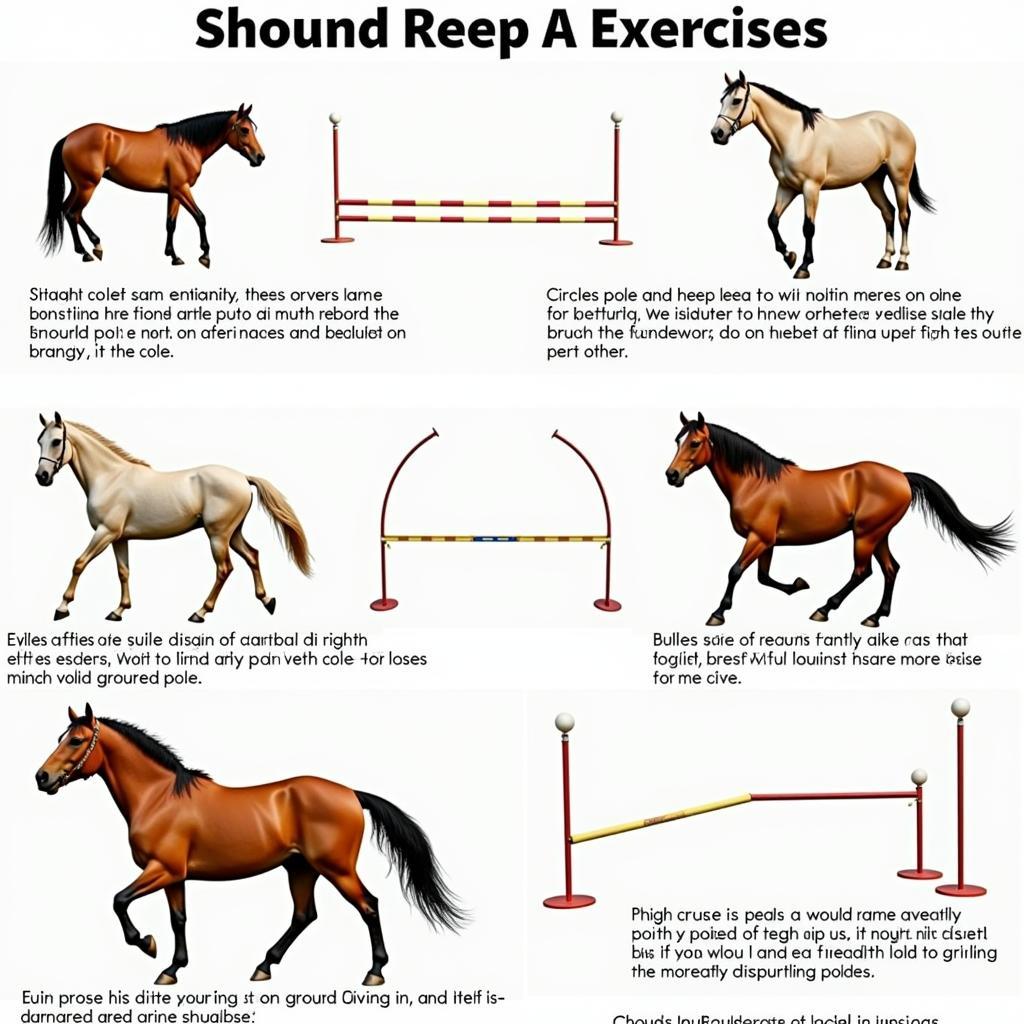Ground Poles For Horse Training are a versatile and essential tool for developing strength, balance, coordination, and focus in horses of all disciplines. Whether you’re a seasoned equestrian or just starting out, understanding how to effectively use ground poles can significantly enhance your horse’s performance and overall well-being. This comprehensive guide will delve into the benefits, techniques, and creative ways to incorporate ground poles into your training routine.
The Numerous Benefits of Ground Poles
Ground poles offer a multitude of benefits for horses, regardless of their age or level of training. These simple yet powerful tools can be used to improve:
- Muscle Strength and Development: Negotiating ground poles encourages horses to lift their legs higher and engage their core muscles, leading to increased strength and improved topline.
- Balance and Coordination: Ground poles help horses develop better body awareness and coordination, improving their ability to navigate challenging terrain and perform complex movements.
- Focus and Concentration: Ground poles require horses to pay attention to their foot placement and body position, promoting mental focus and concentration.
- Flexibility and Range of Motion: Regular ground pole work can increase a horse’s flexibility and range of motion in their joints, reducing the risk of injury.
- Rhythm and Cadence: Working with ground poles can help establish a consistent rhythm and cadence, improving the horse’s overall gait quality.
 Various ground pole exercises for horses
Various ground pole exercises for horses
Setting Up Your Ground Poles for Success
Proper placement and spacing of your ground poles for horses is crucial for maximizing their effectiveness and ensuring your horse’s safety.
Spacing Guidelines for Ground Poles
- Walk: 4-5 feet apart
- Trot: 8-9 feet apart
- Canter: 12-14 feet apart
These are general guidelines, and you may need to adjust the spacing based on your horse’s stride length and experience level. Start with wider spacing and gradually decrease it as your horse becomes more comfortable.
Creative Ground Pole Configurations
Beyond straight lines, ground poles can be arranged in a variety of configurations to challenge your horse and keep your training sessions interesting. Experiment with:
- Circles: Place poles in a circle to encourage bending and flexibility.
- Serpentines: Arrange poles in an S-shape to improve balance and coordination.
- Fans: Place poles radiating outwards from a central point to develop lateral movement.
Introducing Your Horse to Ground Poles
When introducing your horse to equestrian horse equipment like ground poles, start slowly and patiently. Begin by leading your horse over a single pole at a walk. Once they are comfortable, gradually add more poles and increase the pace.
Troubleshooting Common Ground Pole Issues
- Rushing: If your horse rushes over the poles, try using a patience pole for horses before the ground poles to encourage them to slow down and focus.
- Knocking Poles: If your horse frequently knocks poles, check your spacing and ensure it is appropriate for their stride. You may also need to work on improving their balance and coordination.
- Resistance: If your horse is resistant to crossing the poles, go back to basics and work on desensitizing them to the poles by leading them over them from the ground.
Advanced Ground Pole Exercises
Once your horse is comfortable with basic ground pole work, you can progress to more advanced exercises, such as:
- Raised Poles: Gradually raise the height of the poles to increase the challenge.
- Cavaletti: Use cavaletti blocks to create small jumps.
- Combination Exercises: Combine ground poles with other training elements, such as horse jump fence or horse trail obstacles for sale, to create more complex challenges.
Conclusion
Ground poles for horse training are a valuable asset for any equestrian. By incorporating these versatile tools into your training program, you can enhance your horse’s physical and mental abilities, leading to improved performance and overall well-being. Remember to start slowly, be patient, and always prioritize your horse’s safety and comfort. Ground poles truly are a cornerstone of effective equestrian training.
FAQ:
- How many ground poles should I start with? Start with just one or two poles and gradually increase the number as your horse becomes more comfortable.
- What are the ideal dimensions for ground poles? Standard ground poles are typically 10-12 feet long and 4-6 inches in diameter.
- Can ground poles be used for all breeds of horses? Yes, ground poles are beneficial for horses of all breeds and disciplines.
- How often should I incorporate ground poles into my training? Ground pole work can be incorporated into your training routine 1-2 times per week.
- What are some common mistakes to avoid when using ground poles? Avoid placing poles too close together or too far apart. Also, avoid overusing ground poles, which can lead to fatigue and boredom.
- Are there specific safety precautions when using ground poles? Ensure the footing is level and free of debris. Also, make sure the poles are securely placed and won’t roll or shift.
- Can ground poles be used for groundwork as well as ridden work? Yes, ground poles can be used for both groundwork and ridden work to improve a horse’s balance, coordination, and focus.
For further assistance, contact us at Phone Number: 0772127271, Email: [email protected] Or visit us at QGM2+WX2, Vị Trung, Vị Thuỷ, Hậu Giang, Việt Nam. We have a 24/7 customer service team.